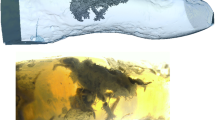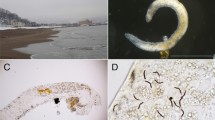Abstract
THE traditional view for the origin of arthropods is that an exoskeleton has evolved once and the three major modern groups, Crustacea (for example, crabs), Chelicerata (spiders) and Uniramia (insects) had a common ancestor in the precambrian. This ancestor was itself related to primitive Onychophora (present day representative, Peripatus) and ultimately to predecessors of the annelids1–4. But, arthropods may have had two, three or several separate evolutionary origins if the external features thought to unite the groups have evolved in response to functionally similar requirements3,5. Studies on trilobite skeleton, for example, suggest two independent ancestral groups whose members were not themselves arthropods. These gave rise on the one hand to the Uniramia and on the other to the chelicerates which were linked to Crustacea through ancestral trilobites6. The discovery of a cell component characteristic of all cell types in insects7 prompted a systematic study of its distribution, to see if it could be of help in determining arthropod evolutionary relationships. We report here that a characteristic feature of arthropods, bismuth staining of the Golgi complex beads, is absent in Peripatus, thus supporting the established view of arthropod evolution.
This is a preview of subscription content, access via your institution
Access options
Subscribe to this journal
Receive 51 print issues and online access
$199.00 per year
only $3.90 per issue
Buy this article
- Purchase on Springer Link
- Instant access to full article PDF
Prices may be subject to local taxes which are calculated during checkout
Similar content being viewed by others
References
Clarke, K. U. The Biology of the Arthropoda (eds Barrington, E. J. W. & Willis, A. J.) 172 (Edward Arnold, London, 1973).
Imms, A. D. Outlines of Entomology 167–170 (Methuen, London, 1942).
Manton, S. M. Zool. J. Linn. Soc. 51, 380 (1972).
Meglitsch, P. A. Invertebrate Zoology 668 (Oxford University Press, New York, 1967).
Tiegs, O. W. & Manton, S. M., Biol. Rev. 33, 255–337 (1958).
Cisne, J. L. Science 186, 13–18 (1974).
Locke, M. & Huie, P. J. Cell Biol. 70, 384–394 (1976).
Locke, M. & Huie, P. Tissue Cell 8, 739–743 (1976).
Locke, M. & Huie, P. Tissue Cell 9, 347–371 (1977).
Jeuniaux, C., Cah. Biol. mar. 16, 597–612 (1975).
Author information
Authors and Affiliations
Rights and permissions
About this article
Cite this article
LOCKE, M., HUIE, P. Bismuth staining of Golgi complex is a characteristic arthropod feature lacking in Peripatus. Nature 270, 341–343 (1977). https://doi.org/10.1038/270341a0
Received:
Accepted:
Issue Date:
DOI: https://doi.org/10.1038/270341a0
This article is cited by
-
The Golgi complex and inter-relationships of arthropods
Nature (1978)
Comments
By submitting a comment you agree to abide by our Terms and Community Guidelines. If you find something abusive or that does not comply with our terms or guidelines please flag it as inappropriate.



